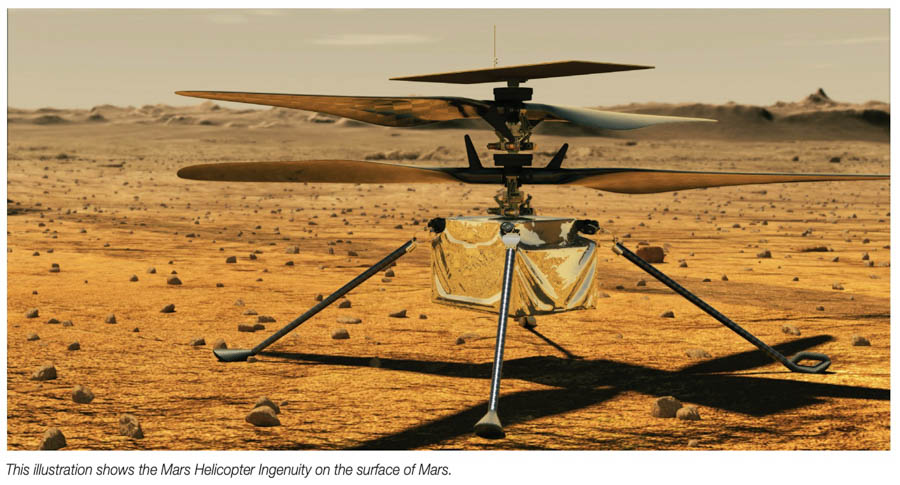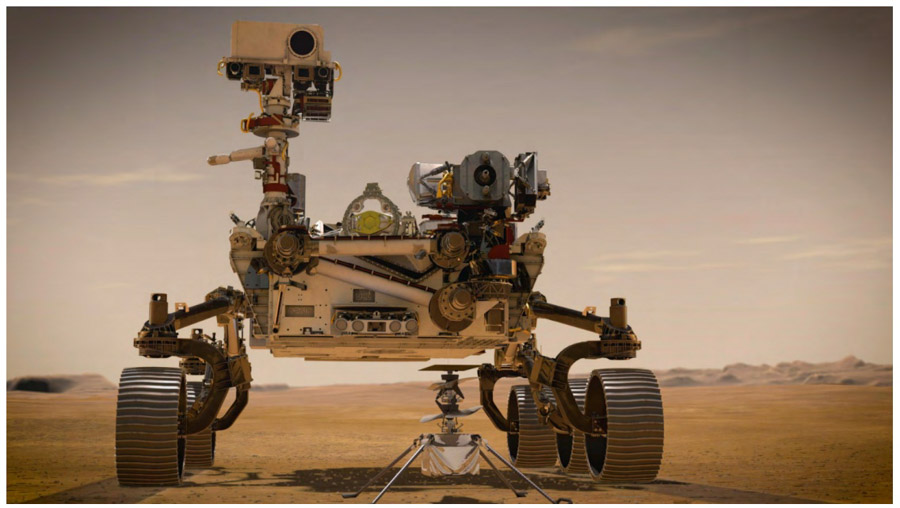
It is remarkable that NASA safely landed still another rover on Mars yesterday. One of the things that makes this Mars mission different is the cargo the nuclear-powered Perseverance rover is carrying on its belly — a helicopter named Ingenuity. Its mission is experimental in nature and completely independent of the rover’s science mission.
About 60 days after landing, the 2,260-pound SUV-sized rover will drop the helicopter a few inches to the surface to test – for the first time ever – powered flight in the thin Martian air. Its performance during experimental test flights will help inform decisions relating to considering small helicopters for future Mars missions, where they could perform in a support role as robotic scouts, surveying terrain from above.

Flying in extreme density altitude
Mars has a rarefied atmosphere – just about 1 percent of the density of our atmosphere on Earth. Taking off from the surface of Mars is the equivalent of flying at an altitude of 100,000 feet on Earth. No terrestrial helicopter has ever flown that high, and that’s more than twice the altitude typically flown by jetliners. Because the Mars atmosphere is so much less dense, Ingenuity is designed to be light, with rotor blades that are much larger and spin much faster than what would be required for a helicopter of Ingenuity’s mass on Earth. The aircraft has four specially made carbon fiber blades arranged into two 4-foot-long (1.2-meter-long) counter-rotating rotors that spin at roughly 2,400 rpm. It weighs 4 pounds and is 1.6 feet in height.
Mars does give the helicopter a little help: The gravity there is only about one-third that of Earth’s. That means slightly more mass can be lifted at a given spin rate.
Rotor system
The rotor blades are powered by electricity generated by a solar array on top of the rotor system that charges six lithium-ion batteries. The stored energy is also used to operate heaters for the very cold Martian nights. The power expended by the helicopter during an up-to-90-second flight is about 350 watts.

Autonomous
While in flight the helicopter is completely autonomous, flying a pre-determined route assisted by a black-and-white camera on the bottom of the aircraft. It can’t be piloted in real time because one-way electronic communication between Earth and Mars at the speed of light takes more than 11 minutes each way.
Communication
Once Ingenuity is deployed on the surface, the rover will act as a communications relay between the helicopter and Earth, and will document the flight tests with its onboard cameras. Commands and programming will be sent from Earth by NASA’s Deep Space Network directly to the Perseverance rover or to Mars orbiters that then relay those transmissions to Perseverance. Perseverance’s main computer will relay the commands and data to an electronics package on the rover called the Helicopter Base Station, which then transmits them to the helicopter up to 3,300 away. During flights, a one-way data stream will be sent in real time from the helicopter to the rover for storage and subsequent retransmission to Earth. After landing, the helicopter will re-transmit the inflight data stream, photos, and additional data from the flight.
Flight performance
- Maximum anticipated altitude of Ingenuity during its flight tests is about 16 feet (5 meters).
- Maximum time aloft during any flight test is expected to be no more than 90 seconds.
- The helicopter’s downward-facing black-and-white camera will take images which are used for navigation (determining position and attitude) in real time during the flight. The horizon-facing 13 megapixel color camera is expected to acquire a few color images during flight.
First experimental flight test on another world
Mars Flight Test No. 1 is scheduled to launch at about 11 a.m. local time on Mars, when winds in the area are expected to be lightest and the battery will be at an adequate state of charge. In addition to using existing wind models, the teams will also be regularly checking data from the rover’s Mars Environmental Dynamics Analyzer (MEDA) instrument, which will provide data on the winds in the vicinity.
By the time of liftoff, the helicopter’s flight computer will have autonomously run through a series of preflight checks and run the rotor system to around 2,400 rpm. If everything remains go, the computer will command the rotor blades to change their angle, or pitch, taking a deeper bite into the tenuous Martian atmosphere. The first attempt at powered, controlled flight from Mars will begin a fraction of a second later.
The goals of Flight Test No. 1: lift off, climb, hover, and land. Ingenuity will be tasked with climbing at about 3 feet per second (1 meter per second) to an altitude of about 10 feet (3 meters). Then it is expected to hover for about 20 seconds and descend at about 3 feet per second (1 meter per second) until touchdown.
Flight tests will be divided into three-sol blocks. One Mars day, or sol (one rotation), is 24 hours, 39 minutes long. In addition to flying the helicopter, engineers use the first sol of each block for activities, including finalizing and transmitting the command sequences and acquiring preliminary data after the flight test’s completion. As soon as these first glimpses (including two low-resolution images taken in-flight) are downlinked, the Ingenuity team will begin reconstructing the vehicle’s performance and planning the next sortie. The second day’s communication from the helicopter will include all the engineering data acquired during the test. The images taken during the flight (up to four black-and-white navigation and three color) will be received on Day 3, providing the helicopter team an even clearer “picture” of what took place in the air millions of miles away. Later that evening, the team will meet to decide whether to begin a new test block the following day and, if so, what kind of flight profile to attempt.
Flight Test No. 2 and Beyond
If the team declares the first test flight a success, the goals of Flight Test No. 2 could be expanded to include climbing to 16 feet (5 meters) and then flying horizontally for a few feet (meters), flying horizontally back to descend, and landing within the airfield. Total flight time could be up to 90 seconds. Images from the helicopter’s navigation camera will later be used by project team members on Earth to evaluate the helicopter’s navigation performance.
If the second experimental test flight is a success, the goals of Flight Test No. 3 could be expanded to test the helicopter’s ability to fly farther and faster – up to 160 feet (50 meters) from the airfield and then return. Total flight time could be up to 90 seconds.
If the project timeline allows for Flight Tests No. 4 and 5, the goals and flight plans will be based on data returned from the first three tests. The flights could further explore Ingenuity’s aerial capabilities, including flying at a time of day where higher winds are expected and traveling farther downrange with more changes in altitude, heading, and airspeed
The NASA video below describes the Ingenuity Mars Helicopter mission.

I grew up watching the Apollo Moon missions and dreaming of flight. When I joined the Army, I was selected for flight training and realized my dream. I retired from the military after 30 plus years as a Master Army Aviator qualified in AH-64A, UH-60A/L, OH-58 A/C, UH-1H and AH-1 helicopters. Now to see that the first powered flight test on another planet will be a helicopter? Absolutely amazing. Thanks to NASA and the team and to all who came before.
With the extremely high density altitude they couldn’t find a long enough runway for a fixed wing take off. Since helicopter lift increases dramatically as soon as translational speed is achieved they probably figured that once it was able to hover the chances were less it would hit something, however I wouldn’t want to be a tiny passenger if they need to autorotate. Those blades are probably some of the lowest inertia blades around and autorotational descent rate must be scary fast. Probably better to just jump, you might fall slower.
Gee when they retire it they can add some retardant tanks!!! lol
It’s basically a $35,000,000 ceiling fan.
This is so wonderful! How about those RPM? I think that the UAV will accomplish a lot even in in 90 seconds.